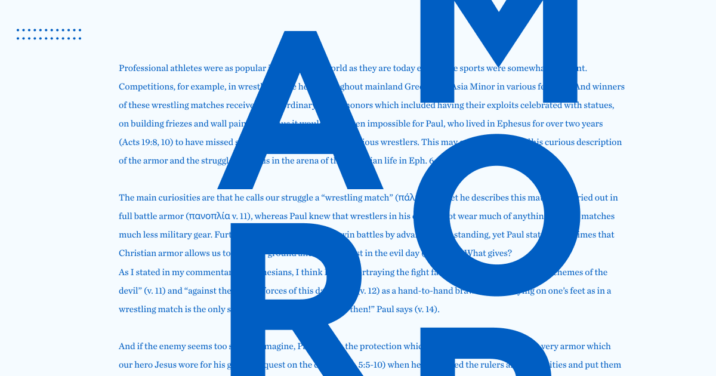Professional athletes were as popular in the ancient world as they are today, even if the sports back then were somewhat different. Wrestling competitions, for example, were held throughout mainland Greece and Asia Minor in various festivals. And winners of these wrestling matches received extraordinary public honors: their exploits were celebrated with statues, friezes, and wall paintings. Thus it would have been impossible for Paul, who lived in Ephesus for over two years (Acts 19:8, 10) to have missed seeing Greek culture’s enthusiasm for victorious wrestlers. This may explain aspects of his curious description of the “armor of God” in Ephesians 6:10–17.
Have you ever noticed that Paul calls our struggle a “wrestling match” (πάλη [pale]) in Ephesians 6:12, yet he describes this match as carried out in full battle armor (πανοπλία [panoplia]) in the previous verse? Paul knew, of course, that wrestlers in his day did not wear much of anything in their matches, much less loads of military gear. Furthermore, soldiers in armor win battles by advancing, not by standing, yet Paul states three times that Christian armor allows us to hold our ground and to “stand” fast in the evil day (vv. 11, 13). “Having done all,” we are to “stand” (Eph 6:13 KJV). What gives? Is Paul mixing his metaphors?
As I stated in my work on Ephesians in Lexham Press’s Evangelical Exegetical Commentary series, I think Paul is portraying the fight facing Christians against “the schemes of the devil” (v. 11) and “against the cosmic forces of this darkness” (v. 12) as a hand-to-hand brawl in which staying on one’s feet—as in a wrestling match—is the only sure way to victory. “Stand fast then!” Paul says (v. 14).
And if the enemy seems too scary to imagine, Paul details the protection which God gives to us, which is the very armor which our hero Jesus wore for his great conquest on the cross (Rev 5:5–10) when he “disarmed the rulers and authorities and put them to open shame, by triumphing over them” (Col 2:15). This is why Paul describes the armor of God which we are to put on in terms of the divine armor of Isaiah worn by the Messiah:
He saw that there was no man,
and wondered that there was no one to intercede;
then his own arm brought him salvation,
and his righteousness upheld him.
He put on righteousness as a breastplate,
and a helmet of salvation on his head. (Isa 59:16–17)
It is worth looking briefly at the different elements of the “panoply of God” (Eph 6:13) which Paul details for us in Ephesians 6:14–17. This armor of God is not only for ancient people but for Christians today.
The belt
The first part of the armor of God is the belt implied when Paul says, “Belt up your waist with truth” (Eph 6:14). An older translation for “belt up your waist” is to “gird one’s loins” (KJV; NKJV): the loose clothing worn in antiquity was pulled up and tied or belted in preparation for wrestling (Job 38:3, 40:7; cf. 1 Pet. 1:13). Here “truth” acts as the belt for believers, and Paul is reminding us that the truth is found in Jesus (Eph 4:21) and his gospel (Eph 1:13). We belt our waists with truth when we speak the truth in love (Eph 4:15, 25) as the fruit of saving faith (Eph 2:8–10) in the battle which Christ, the righteous warrior of God has won for us (Isa 11:5).
The breastplate
The “breastplate” (Eph 6:14) in the armor of God is made of “righteousness” rather than of metal or heavy leather (cf. 2 Cor 6:7). This righteousness is derived from the Messiah’s own “righteousness as a breastplate” (Isa 59:17); it is not our own, because our breastplate is one of faith and love (1 Thess 5:8). Human breastplates might fail on the evil day (Eph 6:13), as Alexander the Great’s did in India when an arrow penetrated his armor and gravely wounded him (Plutarch, Alexander 63.3). It would have done King Ahab well also to have had faith in the Lord, because “a certain man drew his bow at random and struck the king of Israel between the scale armor and the breastplate” (1 Kgs 22:34), and he soon died. But the righteousness and salvation of the Lord showered down from heaven upon us will bear fruit of eternal life from him (Isa 45:8, cf. 11:1; John 15:4–5).

The shoes
Paul uses a curious image in Ephesians 6:15 when he mentions the “shoes” that form part of the armor of God. He doesn’t mention the hobnail boots normally worn by soldiers, but says that Christians are to “have your feet shod with readiness.” As such the shoes are “readiness” or “preparation” connected to “the gospel of peace.” That the good news concerns peace is obvious, since Christ is our peace, the one who binds the church together in the Spirit (Eph 2:14–16; 4:3). But a question arises: how does the “gospel” relate to “readiness”? One interpretive option is that Christians should be ready to share the gospel with their neighbors. While this is true, the better option in this context is that we are prepared to meet our foe because this readiness flows from the gospel which we have received through the working of the Holy Spirit (Eph 1:13–14): “having put on the readiness given by the gospel of peace.”
The shield
Of all the elements of the armor of God in Ephesians 6:14–17, the most striking is the shield. Paul says, “In all circumstances take up the shield of faith by which you will be able to extinguish all the flaming arrows of the evil one” (Eph 6:16). Earlier in history, Greeks typically carried a small, round shield; but the shield Paul references here is a large, “barn-door” shield made of leather-covered wooden planks about four by two feet in size. Bowmen sometimes shot arrows which were set alight and therefore were “fiery shafts” comparable to lightning (Pss 7:13, 144:6). Heavy shields soaked in water could hold up to these for a time. But the Christian shield is derived from faith in the Lord who is himself “a shield for all those who take refuge in him” (Ps 18:30; cf. Gen 15:1; Deut 33:29; Ps 3:3; etc.) and can therefore quench all the blazing fire thrown against us.
The helmet
Paul says, too: “Take up the helmet of salvation” (Eph 6:17). This image is derived directly from Isaiah 59:17, a passage in which the Lord himself puts on this helmet to mete out wrath to his enemies and deliver his people (cf. Isa 61:11–12; Eph 1:19–22, 4:8–10). In this instance, believers “put on … for a helmet the hope of salvation” (1 Thess 5:8) rather than winning salvation for ourselves, since salvation is a gracious gift from God (Eph 2:5, 8), an outcome of faith in Christ (1 Pet 1:9).
The sword
The final element in the armor of God that the believer takes up is “the sword of the Spirit, which is the word of God” (Eph 6:17). This is the only offensive weapon in Paul’s list; all the other elements of the armor are defensive, protective. Yet before we rush about with our swords wildly cutting off ears (Matt 26:51), we should note that the weapons of our “wrestling match” are pitted against spiritual forces far beyond our reach. Thus this is the sword of the Spirit; it is the word of God. And because the Holy Spirit inspired and attends it, this word wields “the powers of the age to come” (Heb 6:5) through which people are born anew (1 Pet 1:23). Here, the Spirit himself gives us power to turn aside attacks of darkness and scheming temptations through the divine word, so that we can stand in the evil day, just as did Jesus during his time on earth (Matt 4:1–11; Luke 4:1–10).
The night is far gone; the day is at hand. So then let us cast off the works of darkness and put on the armor of light. (Rom 13:12)
Conclusion
One temptation we have in our examination of the amor of God is to get wrapped up in the armor itself and not in the one who gives it to us. As noted, this armor is the Lord’s own which he wore to defeat all his and our enemies in his great conquest of sin and death to ransom us (Rev 5:5, 9). This means that the “armor of light” given to us in Christ is expressed as our faith in him when we “put on the Lord Jesus Christ” (Rom 13:14) to become “children of the light” (1 Thess 5:5). And the “captain of the Lord’s army” (Josh 5:13–15) has already clothed us with himself in full battle array in our baptism: “For as many of you as were baptized into Christ have put on Christ” (Gal 3:27). Therefore we can stand fast in the evil day because we stand in the “the superabundant magnitude of his power toward us who believe” (Eph 1:19).
Related resources
The Whole Armor of God: How Christ’s Victory Strengthens Us for Spiritual Warfare
Regular price: $10.99






